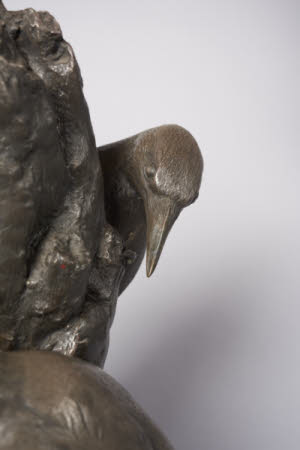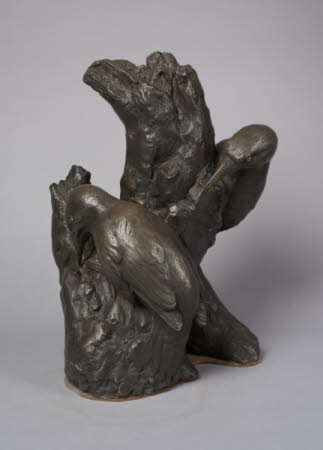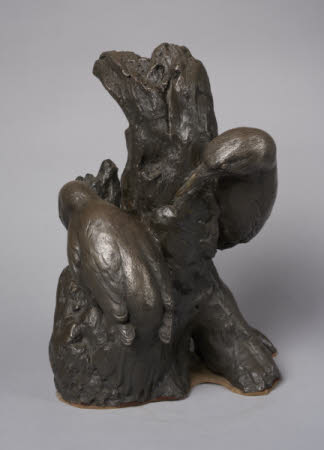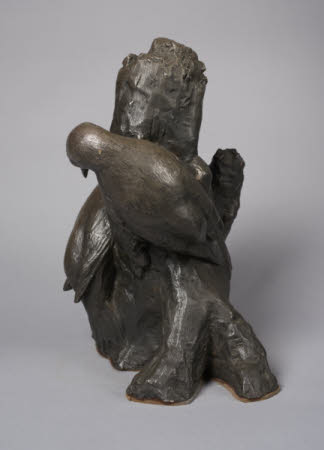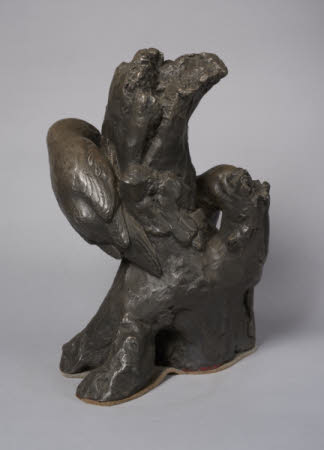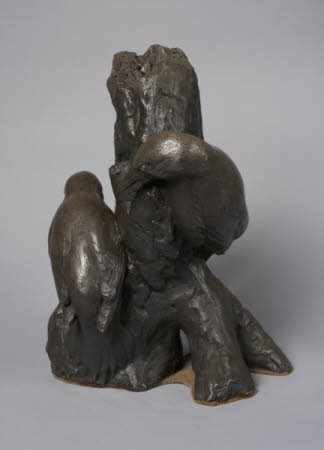Two green woodpeckers
John Hancock (1808-1890)
Category
Art / Sculpture
Date
1875
Materials
Bronze
Measurements
370 mm (H)
Place of origin
Newcastle upon Tyne
Order this imageCollection
Cragside, Northumberland
NT 1228508
Summary
Bronze; two green woodpeckers; John Hancock (1808-90); 1875. A bronze featuring two green woodpeckers upon a branch, by the great natural historian and taxidermist John Hancock. Signed and dated 1875. One of two very rare cast metal sculptures by Hancock that survive at Cragside.
Full description
A bronze group with two green woodpeckers upon a tree branch, searching for food on the branch and in the ground at its base. Signed and dated on tree root. John Hancock is today best known as a taxidermist, who brought new levels of skills to the preparation of specimens of birds and other creatures. Most of his surviving specimens, including some that he exhibited at the Great Exhibition in 1851, are in the former Hancock Museum in Newcastle, today the Great North Museum, whilst there is also a representative collection at Cragside. The Falcon and Two Green Woodpeckers at Cragside are rare examples of Hancock’s skills as a sculptor. John Hancock was the child of another John Hancock (died 1812), a shopkeeper and keen amateur natural historian. None of his and his wife Jane Baker’s six children married, whilst no fewer than four of them became involved in the study of natural history, Thomas Hancock as a geologist, Mary as a natural history draughtsman and John and his brother Albany (1806-73) as zoologists. According to Hancock’s biographer Dennis Embleton, the children had only rudimentary educations, but John and his sister Mary would wander the open country beyond Newcastle. As a young man John Hancock quickly tired of working in the family shop and instead devoted himself to the study of natural history, including plants, insects and especially birds. Hancock’s work as a taxidermist, which came to much wider attention with the display of his work at the 1851 exhibition, was characterised by a much greater attention to naturalistic presentation: ‘he taught how to combine scientific accuracy with artistic feeling’ (Embleton, p. 9), whilst his knowledge of birds became proverbial: ‘John Hancock knew birds thoroughly. At a distance he recognised them by their flight, and nearer, their movements and their notes were all familiar to him. He had observed and sketched their various fashions of plumage for each sex, age, and season, inclusive of their nuptial dresses and habits.’ (Embleton, p. 10). It seems to have been in the 1830s that John Hancock and his brother Albany became interested in modelling, with Albany making portrait busts and John figures or groups of animals and birds. The models were made in clay and then cast in plaster. Embleton listed just eight models made by John Hancock; these included, as well as two models of falcons, ‘a group of Woodpeckers …in plaster’, presumably the model used for casting the group at Cragside, and what is presumably a second cast in the Great North Museum, formerly the Hancock Museum, in Newcastle (Inv. NEWHM: 2006.H6). Hancock seems only occasionally to have made casts in metal from his models. Embleton recorded that a falcon was cast in silver for the Royal Het Loo falconry club and that had made a ‘beautiful bronze’ cast of an eagle with outstretched wings, using for the bronze alloy ‘an antique receipt’ and casting the sculpture ‘at the Gallowgate works of his friend Mr. James Burnett.’ He also made two casts in ‘hardened lead’ of eagles that were formerly on the gateposts of the Hancock Museum and are today on display inside the Great North Museum. The rarity of Hancock’s casts in metal suggests that they were made only to special commission, or for friends, which certainly included Sir William Armstrong. Albany and John Hancock did much to stimulate Armstrong’s love of the natural world, with John also being closely involved in advising on the landscaping of Jesmond Dene, the park given by Sir William to the people of Newcastle. Jeremy Warren March 2022
Provenance
Armstrong collection. Transferred by the Treasury to The National Trust in 1977 via the National Land Fund, aided by 3rd Baron Armstrong of Bamburgh and Cragside (1919 - 1987).
Marks and inscriptions
On tree root, signature:: I. H. 1875 J.H. 1875 (signed)
Makers and roles
John Hancock (1808-1890), sculptor John Hancock (London 1825 - London 1869), sculptor
References
Embleton, Dennis, Memoir of the life of John Hancock, 1891, p. 7.
